5 Best External Microphones for Mac in 2024
Are you searching for pristine audio quality to complement your Mac’s capabilities? Whether you’re podcasting, recording music, or enhancing your video conferencing audio, an external microphone can make a world of difference. With the myriad options available, picking the ideal one for your needs can feel overwhelming. Fear not, because we’ve curated a list of the best external microphones tailor-made for your Mac. These picks promise to deliver top-notch sound clarity and user-friendliness, ensuring your voice is heard loud and clear. Let’s delve into the list that’s sure to elevate your audio experience!
When selecting the best external microphone for a Mac, there are several criteria to consider, ensuring that you get the best audio quality and functionality for your needs. Here’s what to look out for:
- Compatibility: The microphone should easily connect with your Mac, either via a USB port, Thunderbolt, or through a wireless connection without requiring complex setup procedures or additional hardware.
- Sound Quality: Look for a mic that captures clear, crisp audio, which is vital for podcasts, voiceovers, gaming, or professional recordings. A good frequency range and noise-cancellation features can enhance recording quality.
- Purpose: Consider what you’ll use the microphone for. Different mics cater to different needs; for example, podcasters might want different features than musicians or streamers.
- Ease of Use: Any additional features should be straightforward to use and add value without complicating the user experience. This includes plug-and-play capability, on-mic controls, and live monitoring.
- Build Quality: A solid build can ensure longevity and robustness, especially if you plan to use the microphone in various locations.
- Additional Features: Some mics come with useful extras like adjustable stands, shock mounts, or pop filters that can help improve recording conditions.
- Price: Find a mic that provides good value for your budget, keeping in mind the features you’ll actually use.
With these criteria in mind, you’ll be able to choose an external microphone that not only works seamlessly with your Mac but also meets your specific audio recording needs.
Here’s a simplified comparison table for the requested external microphones for Mac, focusing on the key specifications and price. Remember that prices can fluctuate, so the price category is indicated as a range to give a general idea:
| Feature | Blue Yeti USB | Shure MV7 | Rode NT-USB Mini | Audio-Technica AT2020USB+ | Apogee MiC Plus |
|---|---|---|---|---|---|
| Price Range | $ | $$ | $$ | $$ | $$$ |
| Type of Microphone | Condenser | Dynamic | Condenser | Condenser | Condenser |
| Polar Patterns | Cardioid, Bidirectional, Omnidirectional, Stereo | Cardioid | Cardioid | Cardioid | Cardioid |
| Frequency Response | 20 Hz – 20 kHz | 20 Hz – 20 kHz | 20 Hz – 20 kHz | 20 Hz – 20 kHz | 20 Hz – 20 kHz |
| Connectivity | USB | USB/XLR | USB | USB | USB |
| Output Resolution | 16-bit/48 kHz | 24-bit/48 kHz | 24-bit/48 kHz | 16-bit or 24-bit/44.1 or 48 kHz | 24-bit/96 kHz |
| Headphone Jack | Yes | Yes | Yes | Yes | Yes |
| Controls | Mute, Volume, Gain, Pattern selection | Touch panel for Gain, Volume, and Mute | Gain | Headphone volume, Mix control | Gain |
| Compatibility | Mac and PC | Mac and PC | Mac and PC | Mac and PC | Mac and iOS |
Price Range: ($ = budget-friendly, $$ = mid-range, $$$ = premium)
By comparing these specifications, you can decide which microphone best fits your needs and budget. Keep in mind that the perfect microphone for you also depends on the specific use case, like podcasting, streaming, or recording music.
Blue Yeti USB Microphone
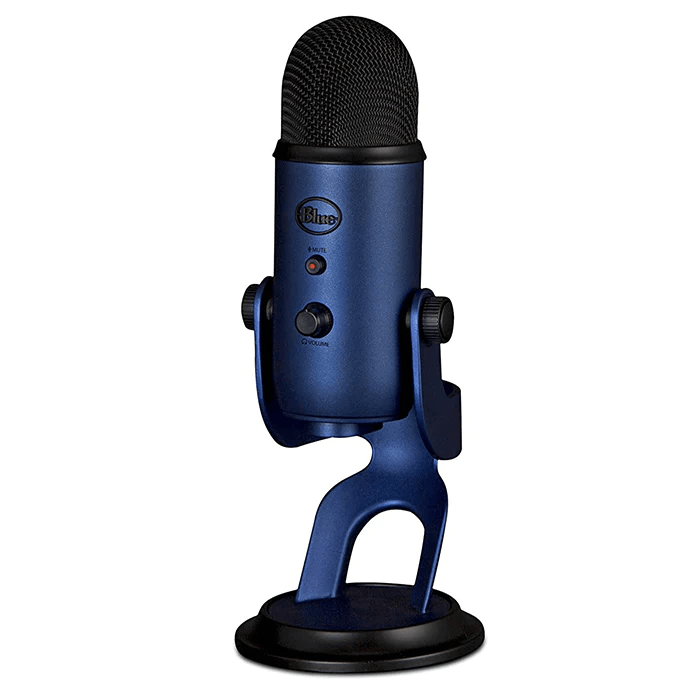
The Blue Yeti USB Microphone is a fan favorite for podcasters, gamers, and musicians alike, thanks to its superb recording quality and ease of use. With its plug-and-play functionality, you can easily connect the Yeti to your Mac without the need for any additional software. The microphone boasts multiple pattern settings—cardioid, bidirectional, omnidirectional, and stereo—offering versatility whether you’re recording a solo podcast or an acoustic jam with friends.
My take on the Blue Yeti is that it’s a stellar performer that punches above its weight in terms of quality and functionality. The robust, retro design not only looks great on your desk but also includes a solid, adjustable stand that ensures the mic stays in the position you set it. Another standout feature is the onboard controls, including a mute button and a gain control knob, which are incredibly handy during recording sessions.
Specs:
- Microphone Type: Condenser
- Polar Patterns: Cardioid, Bidirectional, Omnidirectional, Stereo
- Connectivity: USB
- Frequency Response: 20Hz – 20kHz
- Sample Rate: 48kHz
- Bit Rate: 16-bit
Pros:
- Versatile recording patterns
- No need for external hardware
- Intuitive controls, including a headphone jack for real-time monitoring
- Good build quality
Cons:
- Larger footprint might not be ideal for tight workspaces
- Some users may require an external pop filter for cleaner sound
Price:
The Blue Yeti USB Microphone is usually priced reasonably for its features, often found around $130. However, pricing can fluctuate depending on sales and availability, so it’s worth shopping around for the best deal.
In conclusion, the Blue Yeti is a compelling option for anyone looking to upgrade their Mac’s audio recording capability without entering the realm of professional studio gear. It delivers on the promise of high-quality audio with plug-and-play simplicity, making it an excellent choice for both beginners and experienced users seeking convenience and clear sound.
Shure MV7 Podcast Microphone
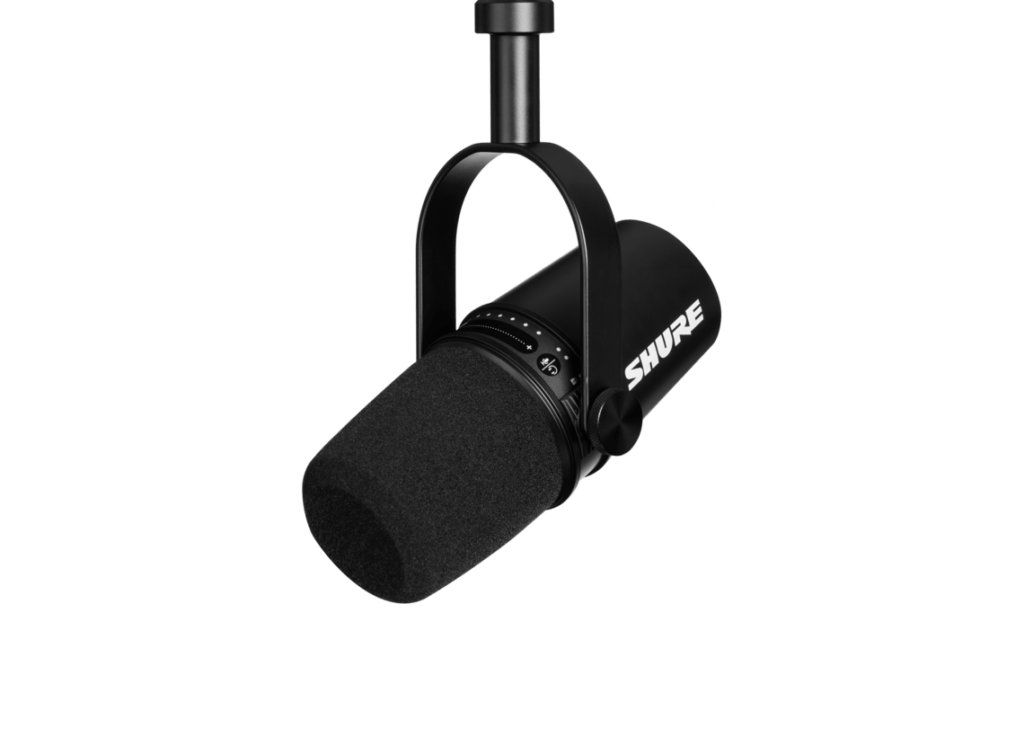
For podcasters, streamers, and vocalists looking for a professional-quality recording mic that effortlessly interfaces with Macs, the Shure MV7 Podcast Microphone stands out. This sleek, dynamic microphone is inspired by the legendary SM7B and offers both USB and XLR connections, making it versatile for various recording setups. The auto-level mode powered by Shure’s MOTIV app is particularly impressive as it simplifies the process of getting great sound for those who might not be audio tech experts.
The sound quality is simply superb—the MV7 captures your voice with great warmth and presence, which makes you sound like you’re broadcasting from a professional studio. The build quality is also exemplary; it feels robust and durable, like it can withstand the rigors of everyday use. Shure’s intuitive touch panel for controlling gain, monitoring volume, headphone mix, and mic muting adds to its ease of use. Whether you’re a veteran podcaster or just starting, this microphone’s ability to deliver radio-worthy audio makes it a top-notch choice.
Specs
- Microphone Type: Dynamic
- Polar Pattern: Unidirectional (Cardioid)
- Connectivity: USB and XLR
- Frequency Response: 50Hz to 16kHz
- Adjustable Gain and Integrated Touch Panel
- ShurePlus MOTIV app compatibility for auto-leveling
- Built-in Headphone Output
Pros:
- Dual USB/XLR connectivity offers great versatility.
- Exceptional audio quality with a rich, warm tone that enhances speech.
- Solid construction with reliable, high-quality components.
- User-friendly with automatic leveling through the MOTIV app.
- A modern design that looks as professional as it sounds.
Cons:
- Lack of multiple polar patterns limits its versatility compared to some competitors.
- Some may find the onboard touch controls a bit sensitive.
- It’s on the pricier side, which might not suit all budgets.
Price
As of my last update, the price of the Shure MV7 Podcast Microphone typically hovers around the $250 mark. While this is not cheap, the investment is justified for serious creators who value audio quality and reliability. The MV7 is an investment that can significantly lift the production value of your content, which in turn can increase audience engagement and, potentially, revenue from your work. Remember that prices may fluctuate over time and across different retailers, so it’s always a good idea to shop around.
Certainly! Here’s the in-depth review of the Rode NT-USB Mini external microphone for Mac, designed for users looking for a quality audio recording solution.
Rode NT-USB Mini
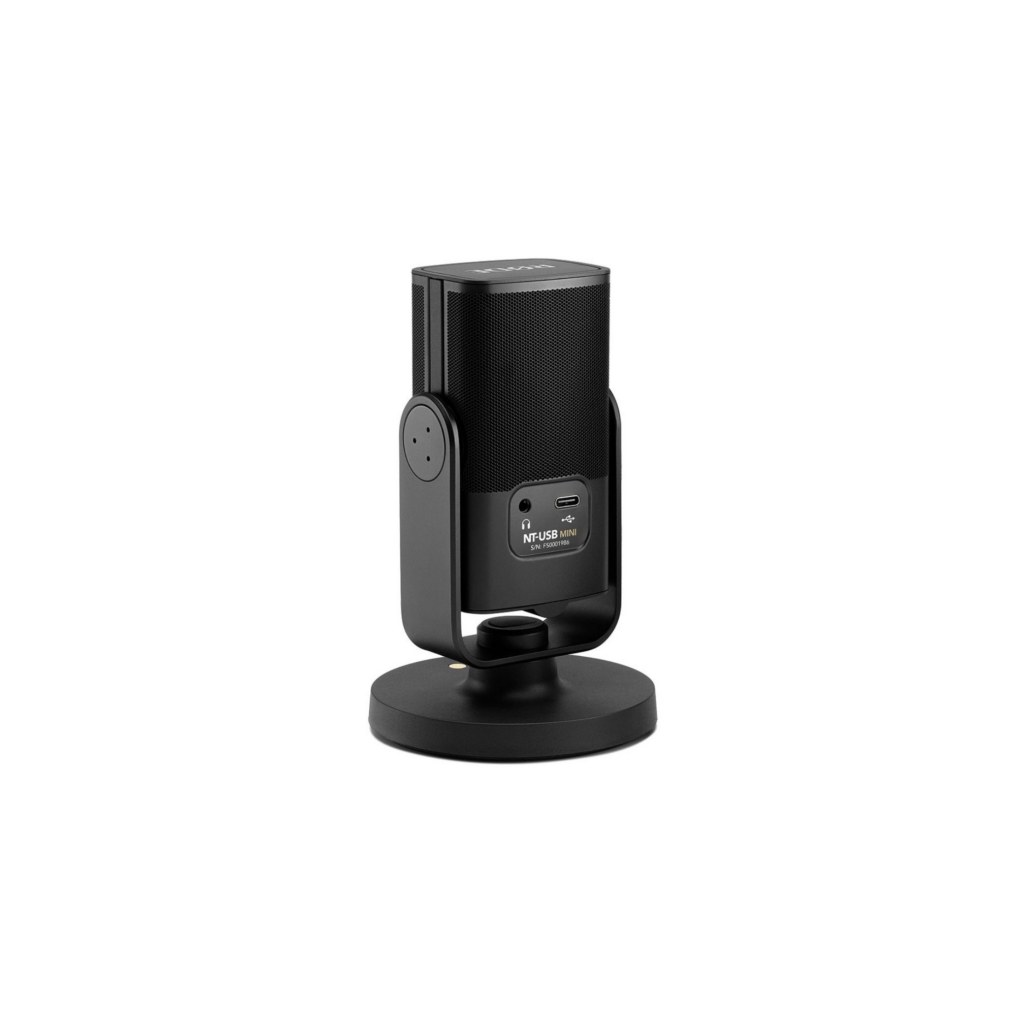
The Rode NT-USB Mini is a compact, studio-quality USB microphone designed for recording directly to a Mac or other devices. Its ease of use and top-notch sound quality make it a fantastic choice for podcasters, streamers, musicians, and content creators who require pristine audio without the complications of an audio interface or additional equipment. My experience with the Rode NT-USB Mini has been overwhelmingly positive; it excels in capturing clear, detailed sound while minimizing background noise, thanks to its cardioid pickup pattern.
One of the standout features is its detachable magnetic stand, which not only provides stability but also allows for easy position adjustment. In terms of build quality, it feels robust despite its compact size, giving me confidence that it can handle regular use without issues.
Specs
- Type: Condenser microphone
- Polar Pattern: Cardioid
- Connectivity: USB-C
- Frequency Response: 20Hz – 20kHz
- Sample Rate: 48kHz
- Bit Depth: 24-bit
- Included Accessories: USB-C to USB-A cable, desktop stand, and ring mount
Pros:
- The audio quality is on par with more expensive microphones, delivering crisp and professional sound.
- It’s incredibly user-friendly; simply plug it into your Mac, and you’re ready to record.
- The magnetic stand and compact design make it convenient for desks with limited space and easy to take on the go.
- With a built-in pop filter, plosives are significantly reduced, enhancing the overall recording quality.
- It feels sturdy and well-made, not cheap or flimsy, which is an important consideration given the investment.
Cons:
- It lacks onboard gain control, which means you have to set levels through your Mac’s audio settings.
- For users who need to record instruments or sound sources from varying angles, the cardioid pattern might be limiting.
Price
As of my last check, the Rode NT-USB Mini tends to be priced around $99. It is, in my opinion, a very fair price point for the quality and performance it delivers. There are cheaper alternatives, but often at the sacrifice of audio quality and build. Meanwhile, more expensive microphones may only offer marginal improvements not worth the cost difference for many users.
In conclusion, the Rode NT-USB Mini strikes a balance between quality and affordability, making it an ideal choice for Mac users looking to upgrade their audio recording capabilities. The few drawbacks it has are minor when considering its overall performance and ease of use.
Audio-Technica AT2020USB+
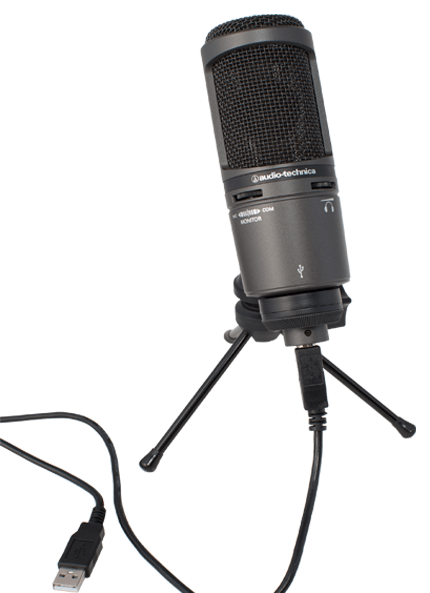
The Audio-Technica AT2020USB+ is a marvel in the realm of plug-and-play microphones, catering especially to Mac users who appreciate crystal clear audio quality without requiring a complicated setup. My experience with this mic has revealed it to be a standout choice for podcasters, musicians, and even avid gamers who demand pristine vocal fidelity.
The microphone itself boasts a sleek and robust design, which is a signature of Audio-Technica’s craftsmanship. The AT2020USB+ is incredibly intuitive to use. Simply connect the mic via the provided USB cable to your Mac, and you’re pretty much ready to go – no drivers needed, which is a breath of fresh air for those who dread complicated installations. The sound capture is rich and detailed, providing a warmth in tone that adds a professional sheen to any recording.
What I particularly admire is the mix control feature, which allows you to blend microphone signal with pre-recorded audio – a dream come true for creators who like to monitor their work on the fly without latency issues. The headphone jack with volume control is equally handy, ensuring you can monitor your sound in real-time with no delay.
Specs:
- Microphone Type: Condenser
- Polar Pattern: Cardioid
- Connection: USB
- Frequency Response: 20Hz – 20kHz
- Sample Rate: 44.1/48 kHz
- Bit Depth: 16 bit
- Controls: Mix control; Volume control
- Compatibility: Mac OS, Windows
Pros:
- Exceptional sound quality with rich, warm audio capture.
- Very user-friendly; plug-and-play with no need for extra gear or software.
- Handy mix control feature for zero-latency monitoring.
- Solid build that promises durability.
Cons:
- Limited to a cardioid pickup pattern – may not be suitable for all recording situations.
- Lack of multiple polar patterns and gain control may deter advanced users seeking more flexibility.
Price:
The Audio-Technica AT2020USB+ strikes a balance between quality and affordability. While it’s not the cheapest option out there, the investment is justified for the level of performance. Expect to spend in the ballpark of $150 to $200 for this microphone. The price point makes it a middle ground option, accessible for serious amateurs but also a worthy tool for professionals on a budget.
In conclusion, the AT2020USB+ has earned a respected spot on my desk for its hassle-free experience and the impeccable audio it delivers. For Mac users who are after a microphone that bridges the gap between consumer and professional-grade without requiring extensive audio knowledge, this is an exceptional pick that won’t disappoint.
Apogee MiC Plus
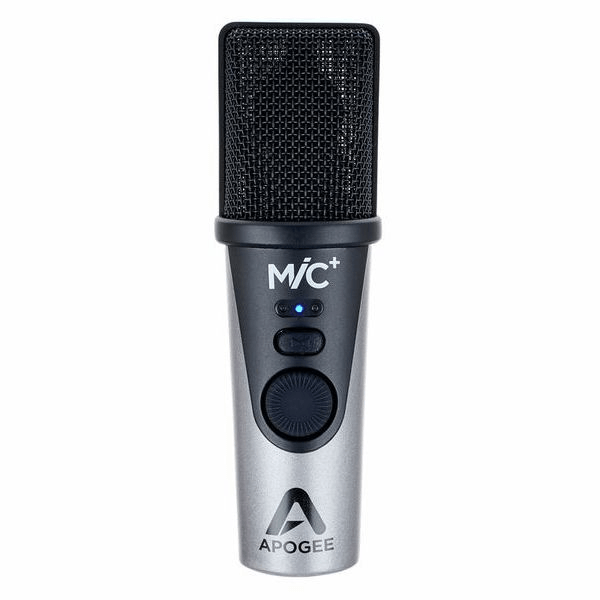
The Apogee MiC Plus is a compact yet powerful tool for Mac users looking to enhance their audio recording capabilities. This sleek device captures sound with incredible clarity and warmth, showcasing its professional studio-quality performance in a portable package. What truly makes the MiC Plus stand out is its simplicity and ease of use. The setup is a breeze, requiring no complex installation; it’s purely plug-and-play, which I appreciate as it saves time and hassle.
Upon using it, the first thing that strikes you about the Apogee MiC Plus is how it makes the vocals sound crisp and vibrant, ensuring that every detail of the performance is captured without compromise. The magic lies in how it harmoniously blends simplicity with sophisticated audio technology – a trait not every external microphone can boast.
Pros:
- Exceptional audio quality that rivals more expensive studio microphones, ideal for podcasters, musicians, or anyone seeking professional-grade sound.
- Highly portable, which I find to be a massive plus for creators on the go or those with limited workspace.
- The inclusion of a headphone output for real-time monitoring is a thoughtful touch, helping users keep tabs on audio quality as they record.
- No latency issues to speak of, which means what you hear in your headphones while recording is exactly what’s being captured.
- Offers a blend of digital and analog technology that enhances tonal quality, often leading to less need for post-processing.
Cons:
- The gain control could be more precise. Although it’s smooth, I feel that when it comes to fine-tuning, there’s room for a more nuanced control to handle a wider range of recording situations.
- MiC Plus is somewhat limited in terms of versatility as it is optimized primarily for voice and acoustic instruments; thus, it may not be the best choice for every recording need.
- Some users might miss having multiple pattern options, which are often available in other microphones within the same price range.
Specs
- Microphone Type: Condenser
- Polar Pattern: Cardioid
- Connectivity: USB, Lightning
- Frequency Response: 20Hz-20kHz
- Sample Rate: 24 bit/96kHz
- Adjustable Gain: Up to 46dB
Price
Regarding price, the Apogee MiC Plus sits firmly in the mid-range bracket. Its cost reflects the quality offered and is justified through its performance. However, for those who are hobbyist or occasional users, the price might seem a tad steep, especially when considering other viable options on the market that come at a lower cost. In any case, for the discerning professional who prioritizes audio quality and simplicity, the price point is certainly within reason.
Conclusion:
In the quest for impeccable audio quality, the right external microphone can make a world of difference, especially for Mac users. Whether you’re a podcasting maestro, a burgeoning vlogger, or a consummate professional seeking crystal clear conference calls, there’s a mic to suit your needs. The best external microphones for Mac not only promise seamless compatibility and ease of use but also cater to various price points and performance requirements. Be sure to consider factors like pickup patterns, connectivity, and additional features as you choose the perfect audio companion to elevate your Mac’s sonic capabilities.
FAQs:
- Do external microphones require additional software to work with a Mac?
Most external microphones designed for Macs are plug-and-play, meaning they don’t need additional software. Once you plug them in, your Mac should recognize the microphone, and you can choose it as your input device in your sound settings. - Can I use an external microphone for both recording and live streaming on my Mac?
Yes, you can use an external microphone for recording audio and for live streaming. High-quality mics will improve sound quality for both applications, but check for features like low latency and stable connections, which are particularly important for live streaming. - What should I consider when looking for a microphone to use in a noisy environment?
If you’ll be using your microphone in a noisy environment, look for one with a cardioid pickup pattern, which is better at isolating your voice and minimizing background noise. Additionally, mics with built-in noise cancellation features can further reduce unwanted sound.
Electric Motor For Industrial Ceiling Fan
Electric Motor For Industrial Ceiling Fan,Efficiency Power Motor,Quiet Cooling Fan Motor,Ceiling Fan Electric Motor
Jiangsu Hengchi Motor Technology Co., Ltd , https://www.hcemotor.com
